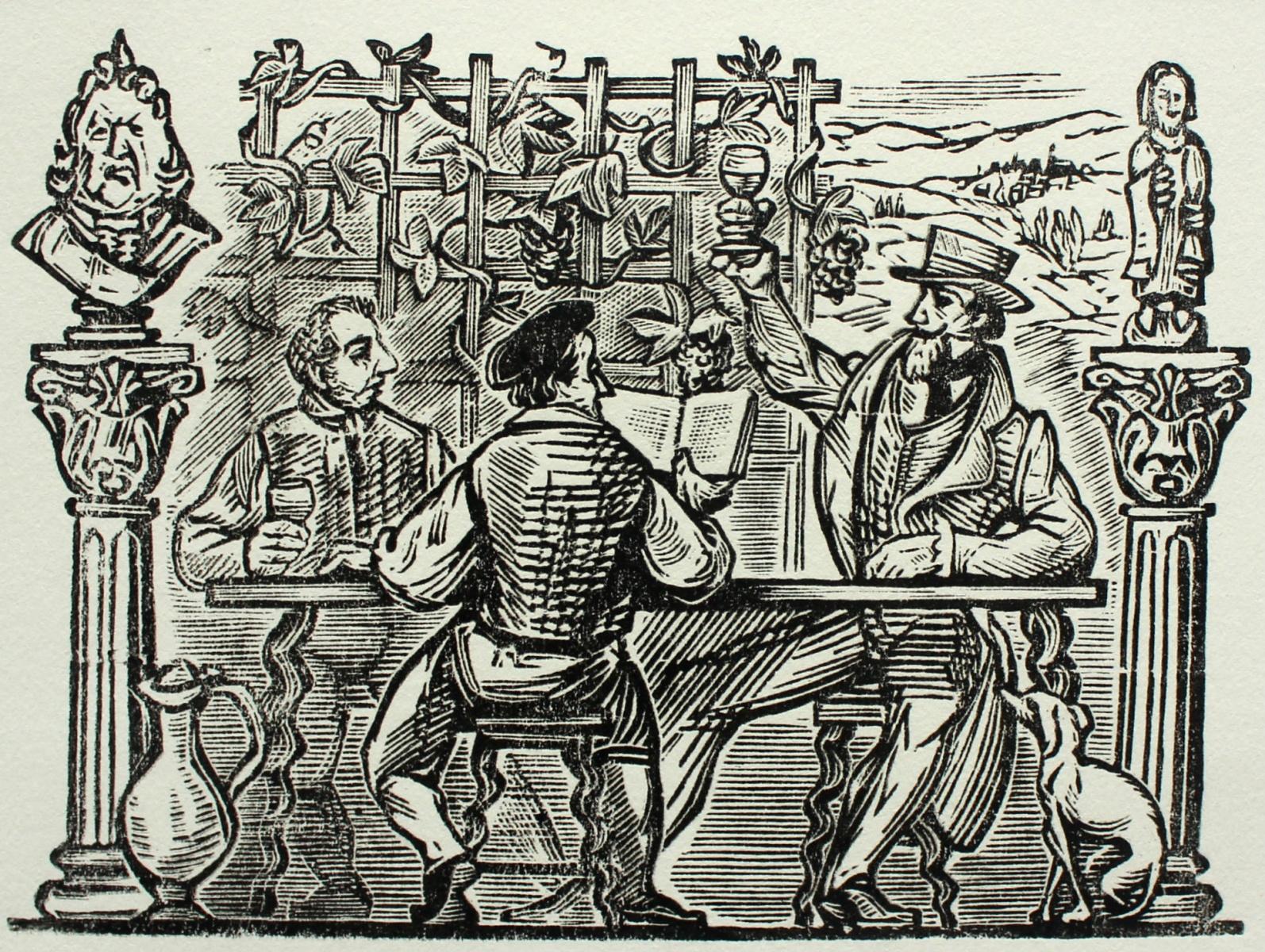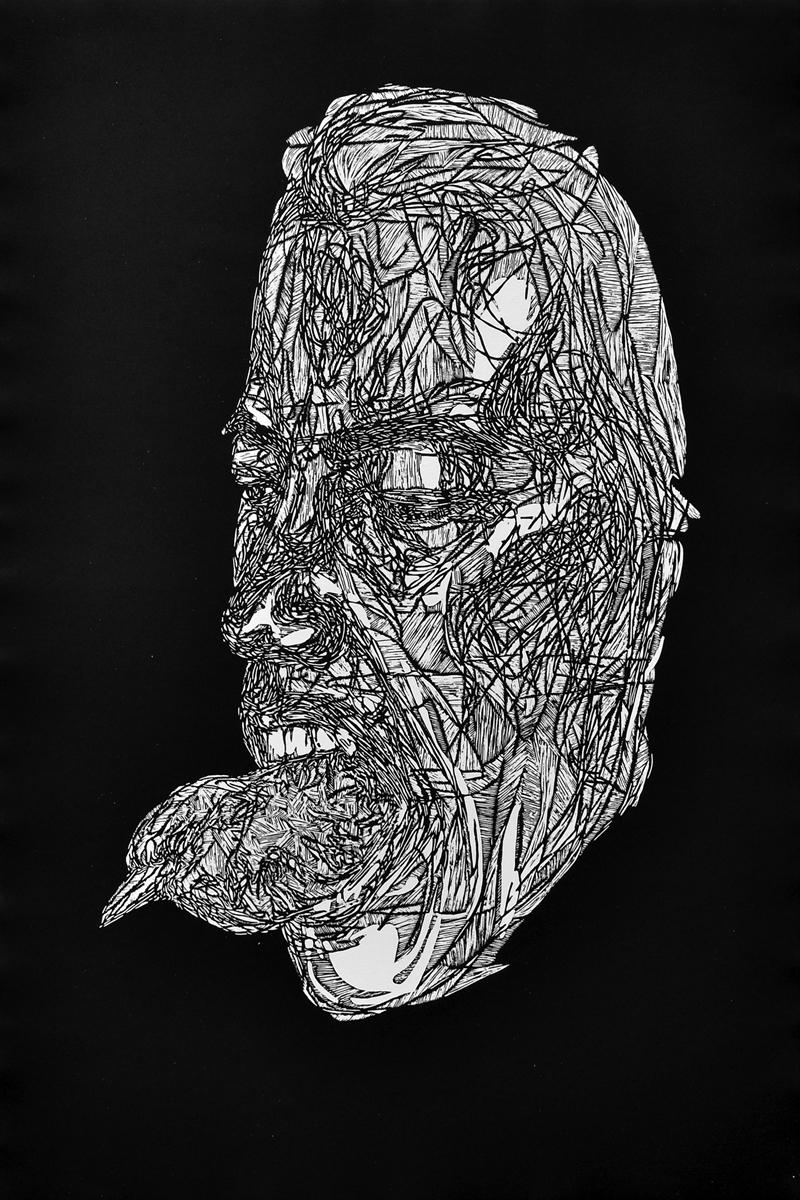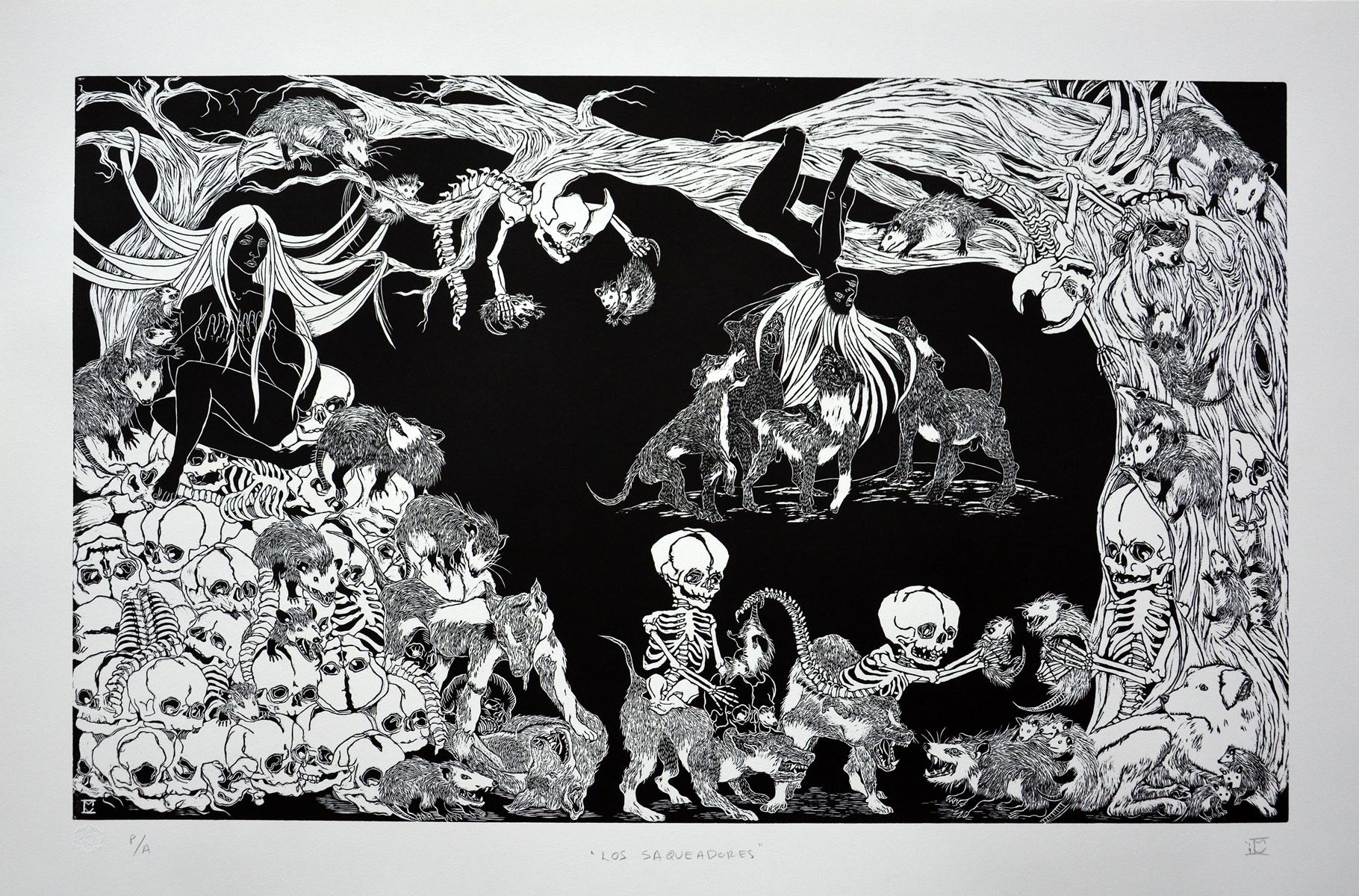Items Similar to St. George — African American artist
Want more images or videos?
Request additional images or videos from the seller
1 of 3
John Tarrell ScottSt. George — African American artist1992
1992
About the Item
John Tarrell Scott, 'St. George', woodcut, edition 20, 1992. Signed, dated, titled, and numbered '18/20' in pencil. A fine, black impression, on off-white, laid Japan paper, with full margins (1 3/8 to 1 3/4 inches), in excellent condition. Scarce. Matted to museum standards, unframed.
ABOUT THE ARTIST
John Tarrell Scott is best known for his monumental woodcuts and his African-Caribbean-New Orleans-inspired kinetic sculptures. Born on a farm in Gentilly, a historic section of New Orleans, Louisiana, his family moved to the Lower Ninth Ward when he was 7 years old. His father was a chauffeur and restaurant cook, and he said his art training began at home where he learned embroidery from his mother.
Scott studied art at Michigan State University and Xavier University of New Orleans, where he later taught art for over 40 years. During the summer of 1983, he received a grant to study in New York under the internationally acclaimed sculptor George Rickey. Since 1965 John Scott has exhibited throughout the United States and internationally. He received an honorary Doctor of Humanities from Michigan State University in 1995 and a Doctor of Humanities from Tulane University in 1997. In 1992, Scott received the prestigious “Genius Grant” from the John D. and Catherine T. MacArthur Foundation for his creativity as one of the nation’s most innovative artists. In 2005, the New Orleans Museum of Art (NOMA) recognized his contribution to American art in a major retrospective, Circle Dance: The Art of John T. Scott.
Scott was commissioned to create several sculptures that are placed throughout the City of New Orleans. These public works in New Orleans include Spirit Gates at the New Orleans Museum of Art and Spirit House at DeSaix Circle (at St. Bernard and Gentilly Boulevards) in the Seventh Ward and River Spirit at Woldenberg Park along the Mississippi River near the Port of New Orleans.
Throughout his artistic career, Scott drew upon the city’s rich African-Caribbean culture and musical heritage. His vibrant, kinetic sculptures explored themes such as the “diddley bow” from West African mythology, or rhythms and movements inspired by early 19th-century African slave dances in the city’s famed Congo Square.
In the catalog accompanying his 2005 retrospective at NOMA, Scott used the words “jazz thinking” in describing his artistic process: “If you listen to a really good jazz group, three things are always evident... Jazz musicians are always in the ‘now’... but these guys are incredibly aware of where they have been and have an unbelievable anticipation of where they are going... To me, that’s jazz thinking. It’s improvisational thinking...” In describing the influence the culture, music, and streets of New Orleans had on his work, Scott often said, “New Orleans is the only city that I’ve been in that if you listen, the sidewalks will speak to you.” Elaborating on what he meant by the city’s special culture, he said: “Other people talk about culture, but I think people here live their culture. When you see people dancing in the street, it’s not about entertaining somebody. It’s not about art. It's about life."
Scott’s work was featured with that of Ed Clark and Eugene J. Martin in the exhibition “Beyond Black” at the LSU Museum of Art, Shaw Center for the Arts, Baton Rouge, LA, January 28 - May 8, 2011. The Mckenna Museum of African-American Art in New Orleans hosted a tribute exhibition of Scott's work in fall 2014.
- Creator:John Tarrell Scott (1940 - 2007, American)
- Creation Year:1992
- Dimensions:Height: 9 in (22.86 cm)Width: 6.13 in (15.58 cm)
- Medium:
- Movement & Style:
- Period:
- Condition:
- Gallery Location:Myrtle Beach, SC
- Reference Number:
About the Seller
5.0
Recognized Seller
These prestigious sellers are industry leaders and represent the highest echelon for item quality and design.
Platinum Seller
These expertly vetted sellers are 1stDibs' most experienced sellers and are rated highest by our customers.
Established in 1995
1stDibs seller since 2016
255 sales on 1stDibs
Typical response time: 1 hour
Associations
International Fine Print Dealers Association
- ShippingRetrieving quote...Ships From: Myrtle Beach, SC
- Return PolicyA return for this item may be initiated within 7 days of delivery.
More From This SellerView All
- Harlem Beauty (Negress, Negro Girl, Black Girl)By Werner DrewesLocated in Myrtle Beach, SC'Harlem Beauty' ('Negress', 'Negro Girl', 'Black Girl'), woodcut, 1930, edition 30, Rose lll.42. Signed, dated, numbered '1 - XXX', and titled 'Negress' in ...Category
1930s Expressionist Portrait Prints
MaterialsWoodcut
- 'Verdi' — 1930s American Modernism - Italian Opera ComposerBy Paul LandacreLocated in Myrtle Beach, SCPaul Landacre, 'Verdi', wood engraving, 1936, edition 60, (only 14 printed), Wien 188. Signed, titled, and numbered '10/60' in pencil. A fine impression, on cream, laid Japan paper, ...Category
1930s American Modern Portrait Prints
MaterialsWoodcut
- 'Richard Wagner' — 1920s Portrait of the ComposerLocated in Myrtle Beach, SCFrancis Coradal-Cugat, 'Richard Wagner', etching, c. 1928. Signed, titled, and numbered ‘2/50’ in pencil with the artist’s inked fingerprint beneath his signature. A fine, richly ink...Category
1920s Romantic Portrait Prints
MaterialsEtching
- 'Garyu no sakura' (The Lying Dragon Cherry Tree, Gifu) — Contemporary JapaneseLocated in Myrtle Beach, SCHajime Namiki, 'Garyu no sakura (The Lying Dragon Cherry Tree, Gifu)', color woodcut, 2003, edition 200. Signed in pencil and with the artist’s red seal....Category
Early 2000s Contemporary Landscape Prints
MaterialsWoodcut
- 'Taos Placita' — 1940s Southwest RegionalismBy Gustave BaumannLocated in Myrtle Beach, SCGustave Baumann, 'Taos Placita', color woodcut, 1947, edition 125. Baumann 132. Signed, titled, and numbered '20-125' in pencil; with the artist’s Hand-in-Heart chop. A superb, richly-inked impression, with fresh colors, on fibrous oatmeal wove paper; the full sheet with margins (2 to 3 1/8 inches); slight rippling at the left sheet edge, in excellent condition. Matted to museum standards, unframed. Image size 9 5/8 x 11 1/4 inches (244 x 286 mm); sheet size 13 1/4 x 17 inches (337 x 432 mm). Collections: New Mexico Museum of Art, Phoenix Art Museum, Wichita Art Museum. ABOUT THE ARTIST Gustave Baumann (1881-1971) was a renowned printmaker and a leading figure of the American color woodcut revival whose exquisite craftsmanship and vibrant imagery captured the essence of the Southwest. "A brilliant printmaker, Baumann brought to the medium a full mastery of the craft of woodworking that he acquired from his father, a German cabinetmaker. This craftsmanship was coupled with a strong artistic training that resulted in the handsome objects we see in the exhibition today. After discovering New Mexico in 1918, Baumann began to explore in his woodblock prints of this period the light. color, and architectural forms of that landscape. His prints of this period are among the most beautiful and poetic images of the American West." —Lewis I. Sharp, Director, Denver Art Museum Baumann, the son of a craftsman, immigrated to the United States from Germany with his family when he was ten, settling in Chicago. From 1897 to 1904, he studied in the evenings at the Art Institute of Chicago, working in a commercial printmaking shop during the day. In 1905, he returned to Germany to attend the Kunstwerbe Schule in Munich, where he decided on a career in printmaking. He returned to Chicago in 1906 and worked for a few years as a graphic designer of labels. Baumann made his first prints in 1909 and exhibited them at the Art Institute of Chicago the following year. In 1910, he moved to the artists’ colony in Nashville, Indiana, where he explored the creative and commercial possibilities of a career as a printmaker. In 1915, he exhibited his color woodcuts at the Panama-Pacific International Exposition in San Francisco, winning the gold medal. Among Baumann’s ongoing commercial activities was his work for the Packard Motor Car Company from 1914 to 1920 where he produced designs, illustrations, and color woodcuts until 1923. In 1919, Baumann’s printmaking work dominated the important exhibition of American color woodcuts at the Detroit Institute of Arts. Twenty-six of his prints were included, far more than the works of any other artist. A set of his blocks, a preparatory drawing, and seven progressive proofs complemented the exhibition. That same year, Baumann worked in New York and, over the summer, in Provincetown, Massachusetts. His airy images of Cape Cod employed soft, pastel colors and occasionally showed the influence of the white-line woodcut technique. Many of his Chicago artist friends had traveled to the southwest, and Baumann became intrigued by their paintings, souvenirs, and stories of an exotic place named Taos, New Mexico. In the summer of 1918, he spent the summer in Taos sketching and painting before visiting Santa Fe. Paul Walter, the director of the Museum of New Mexico, offered him a studio in the museum's basement. Inspired by the rugged beauty of the Southwest—the vibrant colors and dramatic landscapes of the region became a central theme in his work, influencing his artistic style and subject matter for the remainder of his career. Later in the decade, he traveled to the West Coast and made prints of California landscape. Baumann's prints became synonymous with the Southwest, capturing the spirit of its place in America's identity with a unique sense of authenticity and reverence. His iconic images of desert vistas, pueblo villages, and indigenous cultures served as visual tributes to the region's rich cultural heritage, earning him a dedicated following among collectors and curators alike. A true craftsman and artist, Baumann completed every step of the printmaking process himself, cutting each block, mixing the inks, and printing every impression on the handmade paper he selected. His dedication to true craftsmanship and his commitment to preserving the integrity of his artistic vision earned him widespread acclaim and recognition within the art world. About the vibrant colors he produced, Baumann stated, “A knowledge of color needs to be acquired since they don’t all behave the same way when ground or mixed...careful chemistry goes into the making of colors, with meticulous testing for permanence. While complicated formulae evolve new colors, those derived from Earth and metal bases are still the most reliable.” In the 1930s, Baumann became interested in puppet theater. He designed and carved his own marionettes and established a little traveling company. From 1943 to 1945, the artist carved an altarpiece for the Episcopal Church of the Holy Faith in Santa Fe. In 1952, a retrospective exhibition of his prints was mounted at the New Mexico Museum of Fine Arts. Throughout his prolific career, Baumann executed nearly four hundred color woodcuts. Baumann’s woodcuts...Category
1940s American Modern Landscape Prints
MaterialsWoodcut
- 'Theater' — 1920s German ExpressionismLocated in Myrtle Beach, SCA German Expressionist woodcut, with original hand-coloring in watercolor, depicting a parent and child watching a theatrical production; ...Category
1920s Expressionist Figurative Prints
MaterialsWoodcut
You May Also Like
- Red Hat Ada - woodcut, red hat, en face, portrait, red and blackBy Alex KatzLocated in Köln, DE"Red Hat Ada" is a very typical portrait of Alex Katz' wife and life-long muse Ada. Over 70 years of marriage, he has depicted her uncountably often. This is a very outstanding portr...Category
2010s Contemporary Portrait Prints
MaterialsWoodcut
- Lord on the Sand Castle - XX century Black & White Woodcut PrintBy Franciszek BunschLocated in Warsaw, PLIllustration for Jules de la Medelen's "Lord on the Sand Castle" ("Le Marquis Des Saffras") FRANCISZEK BUNSCH (born in 1926) Franciszek Bunsch was born in Bielsko in 1926. He studie...Category
1950s Contemporary Portrait Prints
MaterialsPaper, Woodcut
- Lord on the Sand Castle - XX century Black & White Woodcut PrintBy Franciszek BunschLocated in Warsaw, PLIllustration for Jules de la Medelen's "Lord on the Sand Castle" ("Le Marquis Des Saffras") FRANCISZEK BUNSCH (born in 1926) Franciszek Bunsch was born in Bielsko in 1926. He studie...Category
1950s Contemporary Portrait Prints
MaterialsPaper, Woodcut
- Ana Cazares, ¨Ave en boca¨, 2019, Woodcut, 44.1x29.9 inLocated in Miami, FLAna Cazares (Mexico, ) 'Ave en boca', 2019 woodcut on paper Guarro Biblos 250g. 44.1 x 30 in. (112 x 76 cm.) Edition of 6 ID: CAZ-101 UnframedCategory
2010s Contemporary Portrait Prints
MaterialsPaper, Woodcut
- Isabel Mendoza, ¨Los saqueadores¨, 2019, Woodcut, 29.1x44.1 inLocated in Miami, FLIsabel Mendoza (Mexico) 'Los saqueadores', 2019 woodcut on paper Guarro Biblos 250g. 29.2 x 44.1 in. (74 x 112 cm.) ID: MEI-101Category
2010s Contemporary Portrait Prints
MaterialsPaper, Woodcut
- MusiciansBy Italo ScangaLocated in New York, NYItalo Scanga was born in the Calabria region of Italy, and at 14 immigrated to the United States with his family after World War II. Living in Detroit, he worked on the General Motor...Category
1980s Contemporary Portrait Prints
MaterialsWoodcut
Recently Viewed
View AllMore Ways To Browse
New African If
African Sculptors
Vintage St George
Spirit House Vintage
St George 19th
George Bowes
Historic African
St Bernard
George 3 Japanned
Africa Embroidery
Congo African Art
House Doctor
African American 19th Century
Summer Embroidery
New Orleans Jazz
T Sculpture Dancer
Mississippi River Art
Vintage Square Dance





